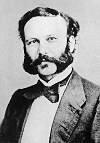|
INTRODUCTION
Rules of war have existed
across all cultures and religions since earliest times. Often they were
informal understandings and principles, codes of chilvary and honour, or
ad hoc agreements negotiated on the battlefield. Modern International
Humanitarian Law (IHL) is different, in that the customs of war have
been written down and formally agreed to as international law by nation
States.
THE
CONTRIBUTION OF HENRY DUNANT
 The
idea began on 24 June, 1859 in Solferino, a town in northern Italy, where
French, Italian and Australian troops were fighting and 40,000 people were
left wounded or dead after only a few hours. The
idea began on 24 June, 1859 in Solferino, a town in northern Italy, where
French, Italian and Australian troops were fighting and 40,000 people were
left wounded or dead after only a few hours.
The sight of the sick and
wounded appalled a Swiss businessman named Henry Dunant who was
travlling in the region. He set about helping them, regardless of their
nationality, and called on the local population to join him, with the rallying
cry "Tutti fratelli" ("All men are brothers").
On his return to Switzerland,
Henry Dunant, unable to forget the horrors he had witnessed, wrote a book
entitled "A Memory of Solferino" calling for measures to limit the
suffering in wartime. Dunant's book led to the creation of a five-member
commission, which in turn, in 1863, became the Geneva-based International
Committee of the Red Cross (ICRC).
In 1864, the ICRC
succeeded in persuading the Swiss Government to convene an international
conference. Sixteen countries participated and the tangible result was
the First Geneva Convention, for the "Amelioration of the Wounded Armies
in the Field", signed by twelve nations.

The red cross on a white
ground, the reverse of the Swiss flag, became the international
symbol of protection, and the identifying symbol of a new worldwide
movement of neutral volunteers. Thus, from the very beginning, the Red
Cross Movement and IHL have been inextricably linked and have developed
side by side.
|

